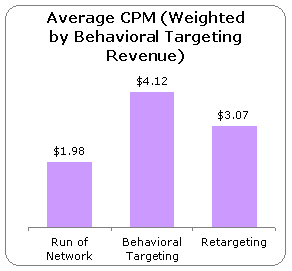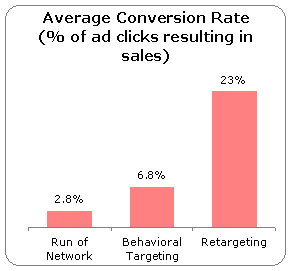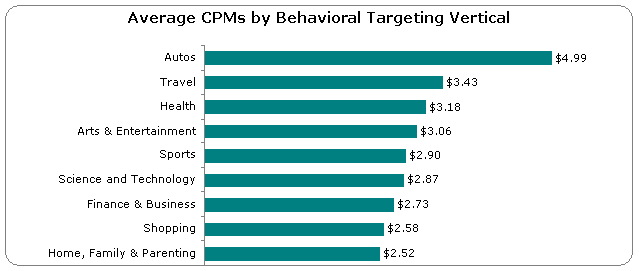Double Down with Behavioral
Based on the study conducted by Howard Beales, an Associate Professor at the School of Business at George Washington University, there are major differences in costs, CTR and conversion rates between behavioral targeting and run of network targeting. The study used data obtained from 12 ad networks, 9 of which were among the top 15 networks by total unique visitors according to comScore’s December 2009 rankings. The three remaining networks this study used are smaller, to provide some representation for smaller networks in the marketplace.
The study shows that the price of behavioral targeting in 2009 was 2.68 times the price of run of network advertising. Consistent with the difference in rates, the conversion rates for behavioral targeting are more than twice the conversion rates for run of network advertising.
As seen in the charts above, the study also shows average cost and conversion rate for retargeting or reengaging a customer who clicked on an ad but did not complete a sale/conversion. However, the retargeting numbers should be taken “with a grain of salt” because only three respondents provided the retargeting data and because the survey did not request information on the division of tasks between the advertiser and the network for this type of advertising.
The high conversion rates imply that behavioral advertising is more interesting and useful to the consumer, and more likely to attract advertisers to the network. If advertising better matches their interests and needs, consumers are more likely to respond to such advertising, and advertisers are willing to pay more for ads delivered to such audience.
Behavioral targeting also improves CTR by as much as 670% over run of network advertising. Although a click through is not the same as sale, it gets consumers closer to sale (making them subject to retargeting) and drives traffic to advertiser’s website.
It is also interesting to see how CPMs compare across different behavioral targeting verticals.
All CPMs are still significantly higher compared to run of network advertising.
Because behavioral targeting makes use of data derived from users’ online behavior, the practice has raised privacy concerns. When asked, most people will say they don’t want their online behavior analyzed. However, evidence suggests that consumers will click and convert through ads that are relevant to them. Similarly, advertisers will pay more for an opportunity to hone in on consumers most likely to buy their product. As for the networks, behavioral targeting accounted for over 40% of their total advertising revenue in 2009.
Post a comment to tell us about your experience with behavioral targeting. We’d love to hear from you!




Saturday, May 29th 2010 at 6:40 am |
That’s Too nice, when it comes in india hope it can make a Rocking place for youngsters.
Tuesday, May 25th 2010 at 6:30 pm |
found it on google. nice. ill come back to visit.
Friday, May 28th 2010 at 3:29 pm |
Thanks! Appreciate it.
Tuesday, May 18th 2010 at 9:07 pm |
Hi there could I quote some of the insight found in this blog if I provide a link back to your site?
Friday, May 28th 2010 at 3:31 pm |
You sure can!